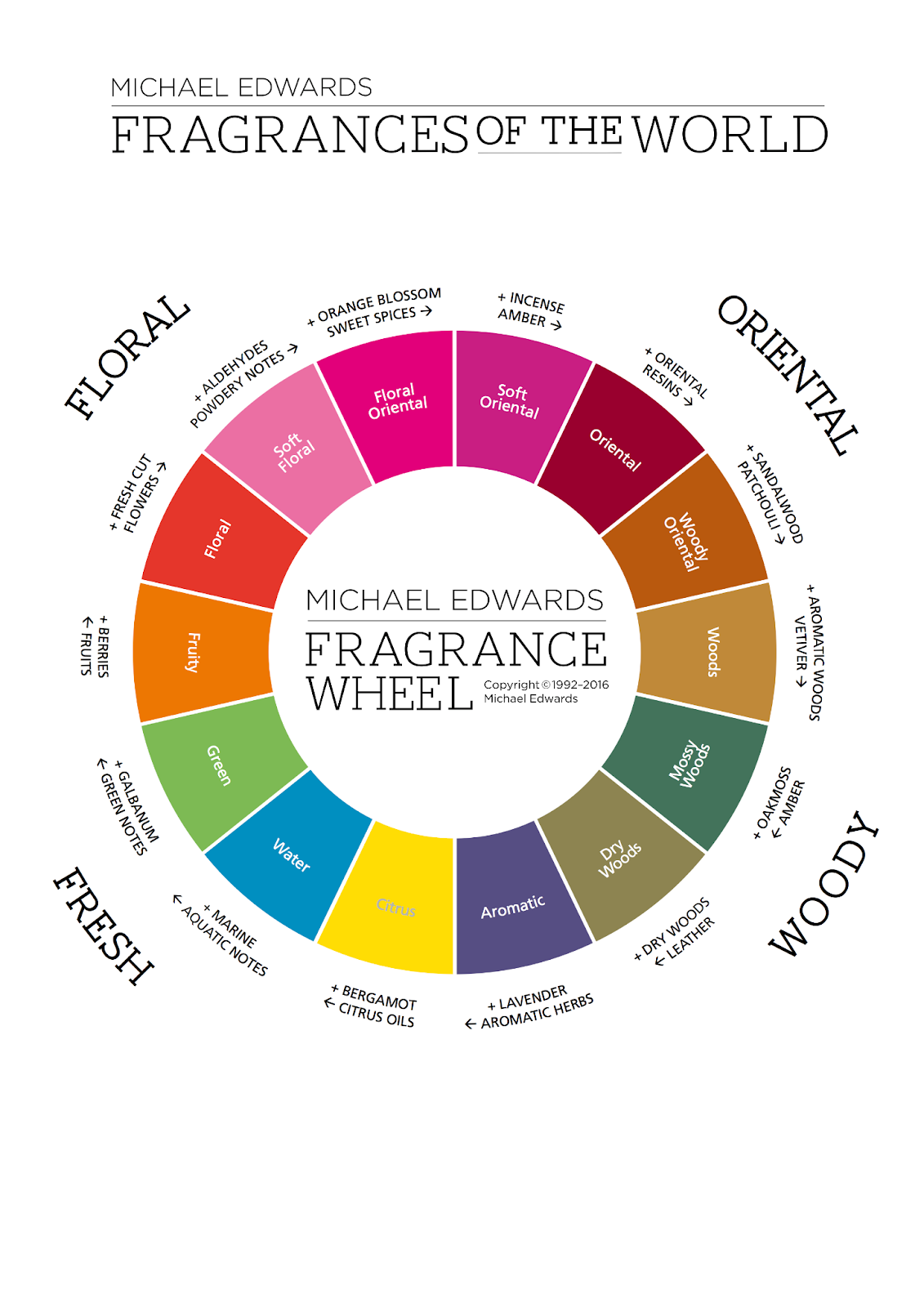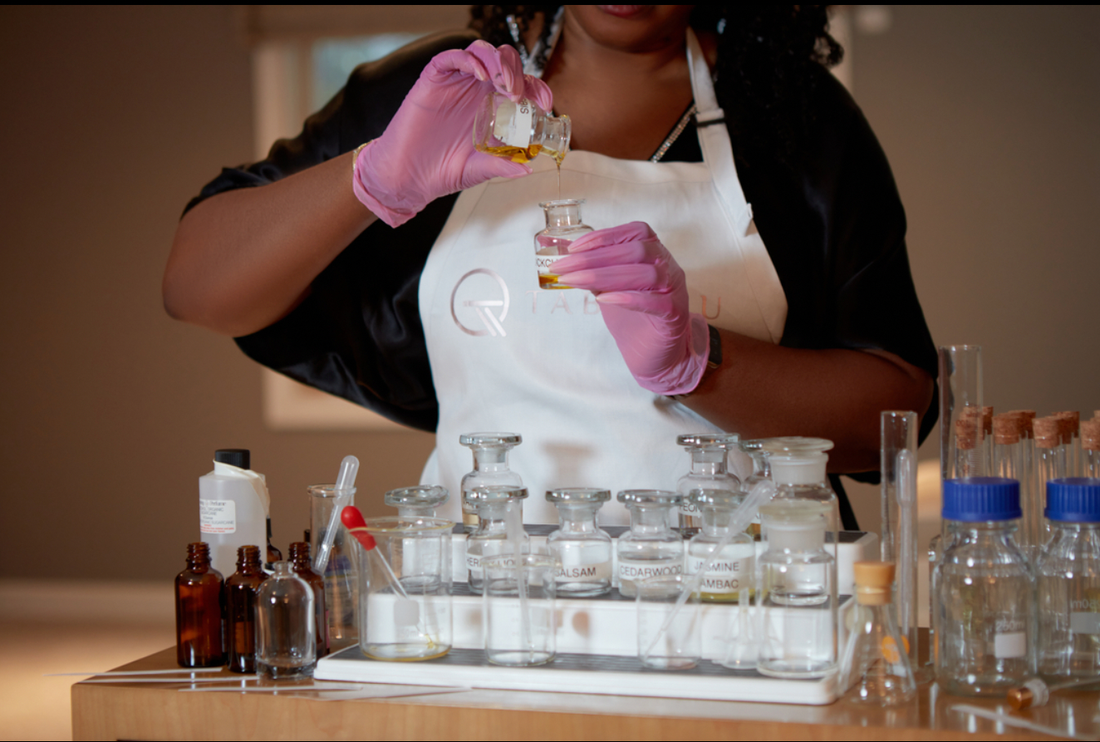Feeling indecisive about choosing a new scent? We get it. With so many different scents for perfumes, deciding on which ones to try can seem overwhelming. How do you choose between floral, spicy, fruity, or woody fragrances? In this guide to the various types of perfume scents, we’ll break down each kind of fragrance and teach you how to pick your perfect scent.
What Are the Different Types of Scents?
When choosing a scent, understanding the different fragrance families will make it much easier for you to decide. The most common perfume scents are grouped into four fragrance families:
- Floral
- Oriental
- Fresh
- Woody
Each fragrance family is then divided into subfamilies based on fragrance notes. You can see all of the families and subfamilies in the fragrance wheel below, created by perfume expert Michael Edwards.

(Photo: Maxiamo Perfumes)
1. Floral
Floral fragrances are the most diverse fragrance family. From chamomile to lily to rose, florals can range from delicate and subtle to intense and bold. Florals are classically feminine, sweet, and romantic. Many floral perfumes contain a single fragrance note, while others incorporate different fragrances families or notes from other flowers.
The floral subfamilies include:
- Floral- Scents with notes of freshly cut flowers.
- Soft Floral- Light, powdery notes soften the intensity of the fragrance.
- Floral Oriental- The addition of aromatic spices adds a seductive earthiness.
- Fruity- Highlights sweet, fruit-forward scents such as cherry, mandarin, and peach.
2. Oriental
Oriental perfumes combine earthy and musky scents to create luxurious fragrances. Oriental scents include vanilla, amber, musk, and cinnamon.
The oriental subfamilies are:
- Oriental- Warm, opulent fragrances with spicy notes like cardamom, jasmine, and black pepper.
- Woody Oriental- Oriental spices mixed with earthy notes such as patchouli and sandalwood.
- Soft Oriental- More subtle oriental scents like incense and amber, often combined with smooth floral notes.
3. Fresh
The fresh fragrance family consists of crisp and refreshing scents. These fragrances are smooth and modest, making them perfect for casual events and day-to-day activities. Some fresh perfumes are water-based while others are citrus or herb-based.
The following fragrances fall into the fresh fragrance family:
- Water- Light and energizing scents composed of aquatic fragrance notes.
- Citrus- Fragrances with a clean and tangy feel: grapefruit, bergamot, lime, etc.
- Aromatic- Herbal perfumes containing ingredients like lavender, sage, rosemary, and basil.
- Green- These scents utilize a vibrant mix of leafy and herbal aromas such as green tea, aquatic plants, and freshly mown grass.
4. Woody
Similar to oriental scents, woody fragrances are warm, bold, earthy, and seductive. Also known as chypre fragrances, these sultry scents include sandalwood, cedar, and oak moss.
The woody subfamilies consist of:
- Woody- Mysterious and aromatic fragrances such as vetiver, sandalwood, and cedar. Woody fragrances are sometimes balanced with florals or citrus.
- Dry Woody- Smoky, dry scents like leather.
- Mossy Woody- Earthy notes including amber and oak moss create a delightfully sophisticated fragrance.
Fragrance Notes
Perfumes typically have top, middle, and base notes. But what does that mean, exactly?
Top notes create the first impression of a fragrance - they’re the first thing you smell when you apply it. The top notes offer a fleeting aroma that dissipates quickly.
Middle notes take over once the top notes disappear. The middle notes are the main attraction, featuring balanced scents that last longer than the top notes
Bottom notes are the most memorable components of a fragrance. The base notes stick around the longest, mixing with the middle notes to create unique and complex scents.
The Different Types of Perfume
You’ve probably noticed that perfumes can have all different sorts of names, from Eau de Toilette to Parfum. But did you know that these names indicate the strength of a fragrance? Let’s break down each type based on perfume strength.
Eau De Parfum
Eau de Parfum, sometimes referred to simply as parfum, retains a fragrance oil concentration of 10-15%. Therefore, it has a lower oil concentration and a higher alcohol and water concentration than parfum. Still, Eau de Parfum is a very strong perfume type that lasts 6-8 hours.
Eau De Toilette
Eau de Toilette contains a fragrance oil concentration of 4-15%. This light fragrance perfume is usually stored in a spray bottle due to its relatively low concentration of fragrance oil and high alcohol content. It usually lasts 2-4 hours.
Eau De Cologne
The cologne perfume type was originally formulated for those who want a lighter variation of a particular scent. But over time, it has now evolved into a masculine scent. Cologne mainly maintains a fragrance oil concentration of 2-5% and it also lasts 2-4 hours. Therefore, men's fragrances come as eau de cologne and are often marketed as an aftershave or splash-on fragrance.
Eau De Fraiche
Eau de Fraiche, also known as fragrance water, is the cheapest and lowest concentration perfume type. It usually contains a fragrance oil concentration of 1-3% and dissipates within an hour or two. Therefore, it is the perfect summer product for beach and gym occasions.
Parfum
Parfum is the type with the highest concentration of fragrance oils and therefore remains the most expensive of the perfume types. It usually contains a fragrance oil concentration of about 15-40% which makes it denser, oily, and stronger. Its strong scent makes it easier to identify compared to other types of perfumes.
How to Find Your Fragrance
Now that you’re familiar with the types of scents and perfumes, are you ready to delve into our selection of handcrafted natural fragrances? Here are some tips to help you choose the right scent for you!
Make a List of What You Like
We all have favorite smells. Which ones do you typically gravitate towards? Make a list of the scents you often choose for hand soap, incense, body wash, or laundry detergent, and sample some perfumes with similar notes.
Understand That Skin Chemistry Affects Perfume Chemistry
Remember that fragrances smell different on everyone due to each body’s unique chemistry. Hormone levels, skin type, and even your diet can determine the way a perfume smells on your skin. Let yourself explore a variety of scents from each fragrance family to find the right fit.
Try Before You Buy
Before you commit to a new fragrance, the best way to find out if you like it is to try it for yourself! With so many different scents and combinations out there, you may be surprised which scents you end up loving.
Sample our most loved perfumes with the Signature Discovery Set!
References:
https://www.perfumedirect.com/pages/a-guide-to-perfume-strengths-and-types
https://www.byrdie.com/types-of-perfume-scents
https://www.feelingsexy.com.au/blog/4-types-of-perfume-scents-and-how-to-pick-one
https://www.stylecraze.com/articles/8-basic-types-of-perfumes/

